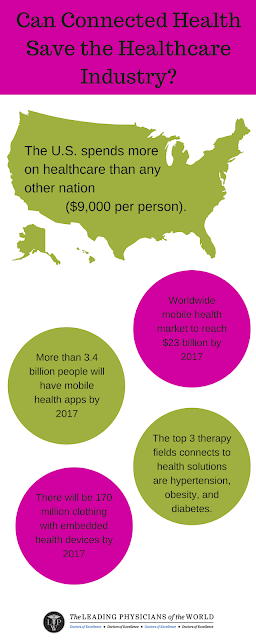Connected Health save Healthcare Industry
Technology-enabled
care, or connected heath care as it is known, is helping to redefine the
patient-caregiver relationship and simplify treatment, from diagnosis to cure.
For technologists, it means more capable, smarter gadgets that can read a
person’s vitals more accurately, determine whether there is or could be a
problem, and then proactively treat the patient without him or her ever knowing
there was an issue. Health care, then, becomes proactive. For providers,
connected health care can open up a whole new model based on value, not the
number of procedures performed. And it offers new, easier ways to interact with
patients. Also, connected health care means a friendlier, more satisfying
experience—something like a new lease on life.
But, even
as healthcare has become more effective, it has also become more complex and
costly. Growing and aging populations are putting increased pressure on
health-care systems that are already crashing under the burden of chronic
diseases like cancer and diabetes. The Institute of Medicine estimates that in
the United States alone, some $750 billion a year – about 30% of total
health-care spending – is “wasted on unnecessary services, excessive
administrative costs, fraud, and other problems.” If we are to ensure that
health care remains affordable and widely available for future generations, we
need to think radically how we provide and manage it.
Obviously,
healthcare needs to become connected. It should become completely normal for
medical professionals to share relevant data with colleagues around the world.
Medical devices in hospitals should be able to combine multiple sources of
information. A new generation of consumer technology, such as wearable health sensors
could automatically alert doctors to medical problems before they become acute
episodes. Although such innovations must confront challenges like system
interoperability and the need to protect patients’ privacy, the Internet’s
integration into the travel and banking industries shows what is possible.
Connected
healthcare is becoming a reality. Philips, for example, has developed a
technology that allows doctors to digitally share medical data from a prostate
cancer biopsy with colleagues around the world. In the past, the biopsy could
be shared only physically, which made diagnosing the exact type of prostate
cancer difficult. As a result, surgeons and patients may have opted for
invasive surgery to be safe. Now, teams of doctors worldwide have an additional
tool to work together towards more accurate diagnoses and enhanced treatment
plans for individual patients.
A Connected
Health mindset would enable and deliver a “Continuum of Care” with the patient
at its center, tying together all components and stakeholders within the health
system. By closing the loop between consumers, caregivers, clinicians and
payers, this approach would promote participatory medicine. Moreover, rather
than episodic care tied to certain events, a Connected Health mindset would
shift the outlook toward wellness and enable individuals to always avail of
appropriate care no matter where they are, in order to remain as healthy as
they can.
Connected
Health solutions could help relieve the pressure being felt by providers and
insurers alike and enable them to effectively manage the total cost of care. There
are practical and feasible ways to effect change and deliver results that the
Healthcare Reform Law aims for in the short term by altering the way we approach
healthcare. The key lies in adopting a Connected Health mindset, which means
keeping the consumer at the center, closing the loop between various
stakeholders, and aiming to deliver a “Continuum of Care”, thereby realizing
significant savings.




Comments
Post a Comment